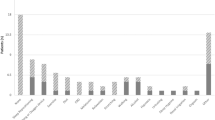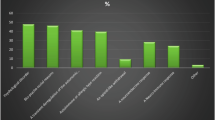Abstract
Post-orgasmic illness syndrome (POIS) is a rare condition that includes a cluster of post-ejaculatory symptoms with debilitating physical and psychological consequences. The prevalence and incidence of POIS remain unknown as well as the pathophysiology of the syndrome, and there are no well-studied recognized treatment modalities. The current retrospective observational study describes a series of 14 highly selected patients who were actively looking for medical help as POIS has a significant effect on patients and their partners. The aim is to increase knowledge about this syndrome and possible treatment modality. According to a standard protocol, patients have been systematically interviewed, had a physical examination, laboratory blood tests, and treatments. Mean age was 34.07 ± 6.65 years. The majority of patients had only one symptom in common—extreme fatigue. The most prevalent complaints were head pressure/heaviness, nose congestion and muscle tension; all patients suffered from more than 1 symptom. POIS started on average within 30 min of ejaculation and lasted for 3.5 days. The patients reported emotional and psychosocial burden of their symptoms, which also influence their partner and relationships. Immunoglobulin-E measurements did not show elevated levels and/or significant increase within 24 h after ejaculation. Silodosin, a highly selective alpha1A-blocker, which actually causes anejaculation, was effective treatment in 57% of the patients.
This is a preview of subscription content, access via your institution
Access options
Subscribe to this journal
Receive 8 print issues and online access
$259.00 per year
only $32.38 per issue
Buy this article
- Purchase on Springer Link
- Instant access to full article PDF
Prices may be subject to local taxes which are calculated during checkout

Similar content being viewed by others
References
Waldinger MD, Schweitzer DH. Post orgasmic illness syndrome: two cases. J Sex Marital Ther. 2002;28:251–5.
Waldinger MD. Post orgasmic illness syndrome (POIS). Transl Androl Urol. 2016;5:602–6. https://doi.org/10.21037/tau.2016.07.01
Nguyen HMT, Bala A, Andrew T, Gabrielson AT, Hellstrom WJG. Post-orgasmic illness syndrome: a review. Sex Med Rev. 2018;6:11–15. https://doi.org/10.1016/j.sxmr.2017.08.006
Waldinger MD, Meinardi MM, Zwinderman AH, Schweitzer DH. Postorgasmic illness syndrome (POIS) in 45 Dutch Caucasian males: clinical characteristics and evidence for an immunogenic pathogenesis. J Sex Med. 2011;8(part 1):1164–70. https://doi.org/10.1111/j.1743-6109.2010.02166.x
Jiang N, Xi G, Li H, Yin J. Postorgasmic illness syndrome (POIS) in a Chinese man: no proof for IgE-mediated allergy to semen. J Sex Med. 2015;12:840–5. https://doi.org/10.1111/jsm.12813
Le TV, Nguyen HMT, Hellstrom WJG. Postorgasmic illness syndrome: what do we know so far? J Rare Dis Res Treat. 2018;3:29–33.
Ashby J, Goldmeier D. Postorgasm illness syndrome–a spectrum of illnesses. J Sex Med. 2010;7:1976–81. https://doi.org/10.1111/j.1743-6109.2010.01707.x
Waldinger MD, Meinardi MMHM, Schweitzer DH. Hyposensitization therapy with autologous semen in two Dutch Caucasian males: beneficial effects in postorgasmic illness syndrome (POIS; Part 2). J Sex Med. 2011;8:1171–6. https://doi.org/10.1111/j.1743-6109.2010.02167.x
Strashny A. First assessment of the validity of the only diagnostic criteria for postorgasmic illness syndrome (POIS). Int J Impot Res. 2019;31:369–73. https://doi.org/10.1038/s41443-019-0154-7
Bignami B, Honore T, Turmel N, Haddad R, Weglinski L, Le Breton F, et al. Post orgasmic illness syndrome. Prog Urol 2017;27:446–9. https://doi.org/10.1016/j.purol.2017.03.007
Mashal A, Beer S. Post orgasmic illness. J Sex Med. 2016;13:S199. https://doi.org/10.1016/j.jsxm.2016.03.271
Rosen RC, Cappelleri JC, Gendrano N. The International Index of Erectile Function (IIEF): a state-of-the-art review. Int J Impot Res. 2002;14:226–44.
Derogatis LR, Lipman RS, Covi L. SCL-90: an outpatient psychiatric rating scale; preliminary report. Psychopharmacol Bull. 1973;9:13–28.
Amarasekera A. Immunoglobulin E in health and disease. Asia Pac Allergy. 2011;1:12–15. https://doi.org/10.5415/apallergy/2011.1.1.12
Kobayashi K, Masumori N, Hisasue S, Kato R, Hashimoto K, Itoh N, et al. Inhibition of seminal emission is the main cause of anejaculation induced by a new highly selective alpha1A-blocker in normal volunteers. J Sex Med. 2008;5:2185–90. https://doi.org/10.1111/j.1743-6109.2008.00779.x
U.S. Department of Health & Human Services. National Institutes of Health. Genetic and rare diseases information center, 2020.https://rarediseases.info.nih.gov/diseases/10809/postorgasmic-illness-syndrome.
POIS Center.com. Post orgasmic illness syndrome (P.O.I.S.): Statistics Center, 2019. https://poiscenter.com/forums/index.php?action=stats.
Naked Science Forum©. The Naked Scientists.com, Post orgasmic illness syndrome (POIS). https://www.thenakedscientists.com/forum/index.php?topic=6576.0, accessed February 20, 2020.
Facebook.com. Private Group. Post orgasmic illness syndrome (POIS). https://www.facebook.com/groups/1457009341209480/, accessed February 20, 2020.
Shigeta K, Kikuchi E, Matsushima M, Daimon T, Yazawa S, Ando T, et al. A clinical case of suspected postorgasmic illness syndrome. J Sex Med. 2013;10 Supp 3:220.
Saitz TR, Serefoglu EC. The epidemiology of premature ejaculation. Transl Androl Urol. 2016;5:409–15. https://doi.org/10.21037/tau.2016.05.11
Kim T, Shim Y, Lee S, Son ES, Shim JW, Lee SP. Intralymphatic immunotherapy with autologous semen in a Korean man with post-orgasmic illness syndrome. Sex Med. 2018;6:174–9. https://doi.org/10.1016/j.esxm.2017.12.004
Diaz RC, Liang J, Hallet L, Meyers AD. Diagnostic allergy testing: specific IgE testing. Medscape. 2016.
Abdessater M, Elias S, Mikhael E, Alhammadi A, Beley S. Post orgasmic illness syndrome: what do we know till now? Basic Clin Androl. 2019;29:13. https://doi.org/10.1186/s12610-019-0093-7
Author information
Authors and Affiliations
Corresponding author
Ethics declarations
Conflict of interest
The author declares that he has no conflict of interest.
Additional information
Publisher’s note Springer Nature remains neutral with regard to jurisdictional claims in published maps and institutional affiliations.
Rights and permissions
About this article
Cite this article
Reisman, Y. Clinical experience with post-orgasmic illness syndrome (POIS) patients—characteristics and possible treatment modality. Int J Impot Res 33, 556–562 (2021). https://doi.org/10.1038/s41443-020-0314-9
Received:
Revised:
Accepted:
Published:
Issue Date:
DOI: https://doi.org/10.1038/s41443-020-0314-9
This article is cited by
-
Post orgasmic illness syndrome: a review
International Journal of Impotence Research (2024)
-
A clinical guide to rare male sexual disorders
Nature Reviews Urology (2024)
-
Recognition and practice patterns of sexual medicine experts towards postorgasmic illness syndrome
International Journal of Impotence Research (2023)



